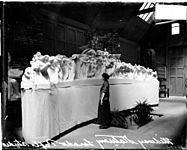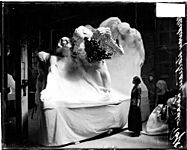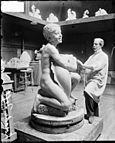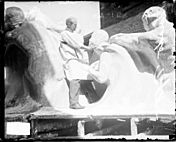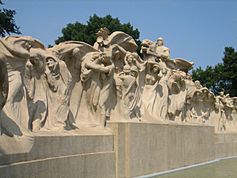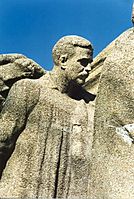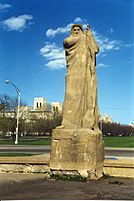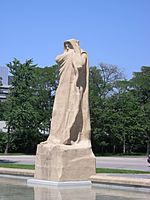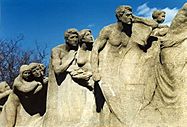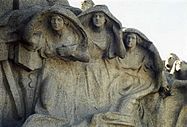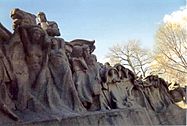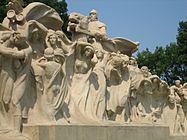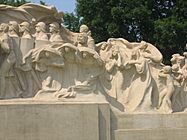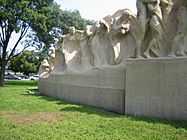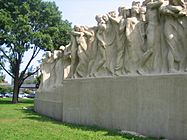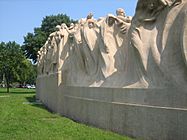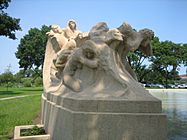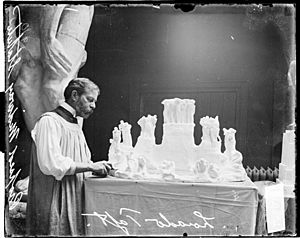Fountain of Time facts for kids
Quick facts for kids Fountain of Time |
|
|---|---|

Fountain of Time in southeast Washington Park at the western edge of the Midway Plaisance
|
|
| Artist | Lorado Taft |
| Year | 1920, dedicated 1922 |
| Type | Concrete |
| Dimensions | 7.3 m × 38.66 m × 7.16 m (24 ft × 126 ft 10 in × 23 ft 6 in) |
| Location | Washington Park (outdoor), Chicago, Illinois |
| 41°47′12.3″N 87°36′27.9″W / 41.786750°N 87.607750°W | |
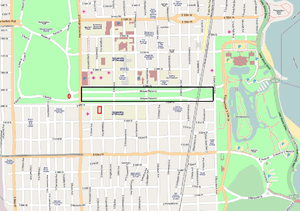
The Fountain of Time, also called Time, is a huge sculpture in Chicago, Illinois. It was created by an artist named Lorado Taft. You can find it in Washington Park, right next to the Midway Plaisance.
This amazing sculpture is inspired by a poem called "Paradox of Time" by Henry Austin Dobson. It shows 100 figures moving past a character called Father Time. These figures represent 100 years of peace between the United States and the United Kingdom. This peace followed the Treaty of Ghent in 1814, which ended the War of 1812.
The fountain's water started flowing in 1920. The sculpture was officially dedicated in 1922. It's an important part of the Washington Park Historic District.
Time was built using a new kind of strong, steel-reinforced concrete. People said it was the first finished artwork ever made from concrete. Before Millennium Park opened in 2004, it was considered Chicago's most important outdoor art piece. Many artworks in Chicago, including Time, were paid for by a special fund from Benjamin Ferguson.
Over the years, Time has needed many repairs. Weather and city pollution caused it to wear down. In the late 1990s and early 2000s, it got major repairs. Even after a big renovation in 2005, people still work to keep it looking great.
Contents
Creating the Fountain of Time
The Fountain of Time was funded by a gift from Benjamin Ferguson in 1905. He left money to create art that would remember important moments in American history. Lorado Taft first imagined the sculpture carved from granite or marble.
The sculpture was meant to be part of a bigger plan to make the Midway Plaisance more beautiful. This plan included streams, ponds, and several bridges. Taft also created another famous sculpture, the Fountain of the Great Lakes, in 1907.
Taft was inspired by the idea of "making no small plans." He wanted to create a grand design for the Midway. He suggested two ideas for the sculpture's theme. One was to honor the World's Columbian Exposition from 1893. The other was to celebrate 100 years of peace between England and America. Since other plans were already in place for the Exposition, the peace theme was chosen.
In 1913, Taft received money to create a full-sized plaster model of Fountain of Time. He first made a smaller model, about 20 feet long, which was approved in 1915. Later, he built the full-size plaster model, which was 100 feet wide. It featured a warrior on horseback and a 20-foot-tall Father Time.
The installation of this model was delayed because Taft served in France during World War I. It was finally completed in 1920. However, the original plan for a grand Midway beautification with expensive materials like granite or bronze didn't happen. Instead, the trust provided enough money only for a concrete sculpture.
Where to Find the Sculpture
The Fountain of Time is located in Washington Park on Chicago's South Side. It's very close to the University of Chicago campus. This area is a federal Registered Historic District.
Many people consider Time to be the most important large-scale artwork in the Chicago Park District. Its importance comes from its famous sculptor, its powerful message, and its unique design. It was also the first finished artwork ever made from concrete.
The sculpture is just a few blocks from Taft's old studio, the Lorado Taft Midway Studios. This studio is now a Chicago Landmark. Other famous sculptures are nearby, like Henry Moore's Nuclear Energy.
The exact size of Time can be confusing, but it's about 127 feet long, 23 feet wide, and 24 feet tall. The water in the sculpture started flowing on September 1, 1920. It was officially dedicated to the city on November 15, 1922.
What the Sculpture Looks Like
The sculpture is made of hollow-cast concrete with steel inside for strength. It was created using a mold with 4,500 pieces. The material used was a special "concrete-like" mix that included pebbles from the Potomac River. This was a new and innovative material at the time.
The sculpture shows a cloaked Father Time holding a scythe. He watches over a parade of 100 figures arranged in a circle. These figures represent all kinds of people at different stages of life. They are described as "heroic" and seem to be rushing through life. You can see soldiers, playful children, and couples in love. Father Time himself is often called "huge" and "dominant."
Time celebrates 100 years of peace between the United States and Great Britain. This peace began after the Treaty of Ghent ended the War of 1812 in 1814. The idea for the sculpture came from the poem "Paradox of Time" by Henry Austin Dobson, which says: "Time goes, you say? Ah no, Alas, time stays, we go."
The sculpture's theme is similar to Shakespeare's famous "All the world's a stage" speech. It talks about the different stages of human life. Taft's figures show birth, the struggle to live, love, family, religion, art, and war.
Most of the figures are general representations of people. However, Taft included himself in the sculpture, along with one of his assistants. He is shown wearing a smock, with his head bowed. His own daughters even posed as models for some of the figures.
Lorado Taft was known for his books, like The History of American Sculpture. He was also famous for creating large public sculptures, and Fountain of Time is a great example. He lived in Illinois for most of his life and worked in the Lorado Taft Midway Studios starting in 1906.
Keeping Time Looking Good
The Fountain of Time was built without special expansion joints. This made it unique but also prone to cracking. Over the years, weather, pollution, and even vandalism caused damage.
Repairs were made in 1936, 1955, and 1966. However, early repair methods sometimes caused more harm than good. For example, using sandblasting or stiff materials to patch cracks wasn't ideal.
By the 1980s, the sculpture was crumbling. Cracks were everywhere, and details on the figures were wearing away. Moisture was damaging the inside of the hollow sculpture. It needed a lot of money for a proper restoration.
Many groups, including the Chicago Park District and the University of Chicago, helped fund the repairs. They worked to dry out the inside of the sculpture and improve its ventilation. They also added a protective coating to the outside.
In 1997, a temporary building was put up to protect the sculpture during winter repairs. Workers reinforced the steel inside and fixed old patches. They also recoated the entire surface by hand.
A major two-year restoration project began in 1999. Workers repaired cracks, removed dirt and pollution, and coated the surface with a special mixture. This phase was finished in 2001, and the sculpture looked much better when its protective structure was removed in 2002. These repairs were expected to last for 30 to 50 years.
In 2003, money was raised to fix the reflecting pool. The pool and its water system were repaired in 2005. For the first time in over 50 years, the fountain was filled with water again! Efforts to add lighting to the sculpture began in 2007.
Gallery
- ''Fountain of Time'' before restoration
- ''Fountain of Time'' after restoration
Fountain of Creation
Lorado Taft had planned for a second fountain, called Fountain of Creation, to be built at the other end of the Midway. However, this project was never fully finished.
The parts of Fountain of Creation that were completed show figures from an old Greek story. This story is about how the Earth was repopulated after a great flood. These finished pieces were given to the University of Illinois at Urbana-Champaign, where Taft had studied.
There are four surviving parts of this work. They are figures between 5 and 7 feet tall. They are known as Sons and Daughters of Deucalion and Pyrrha. Two of these figures stand outside the university's Main Library. The other two are located on the south side of Foellinger Auditorium.
See also
 In Spanish: Fuente del Tiempo para niños
In Spanish: Fuente del Tiempo para niños


